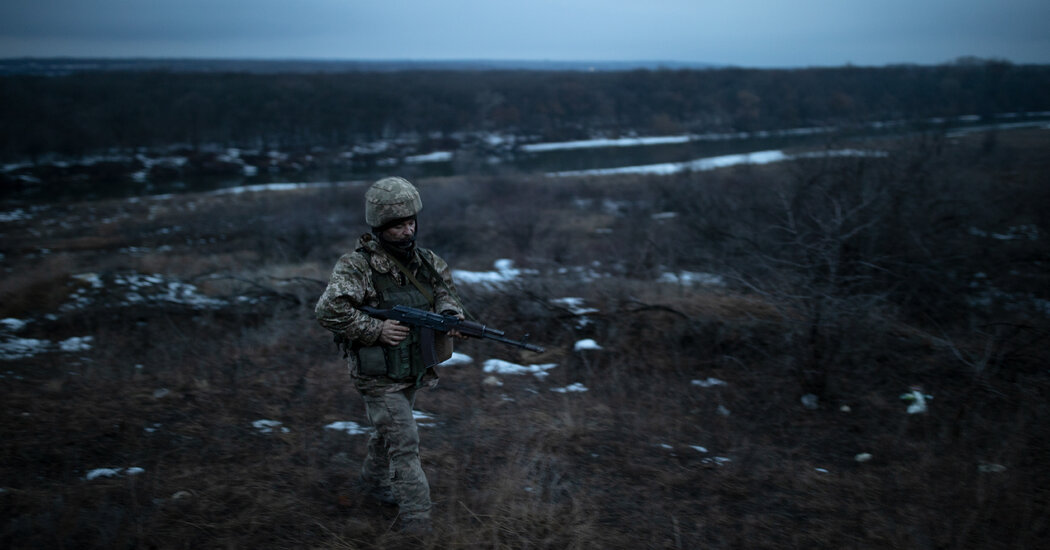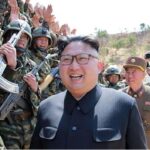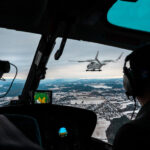
KYIV, Ukraine — There are fields instead of city streets, farmsteads instead of apartment buildings. Open highways stretch to the horizon.
The battles in the north that Ukraine won over the past seven weeks raged in towns and densely populated suburbs around the capital, Kyiv, but the war is about to take a hard turn to the southeast and into a vast expanse of wide-open flatland, fundamentally changing the nature of the combat, the weapons at play and the strategies that might bring victory.
Military analysts, Ukrainian commanders, soldiers and even Russia’s president, Vladimir V. Putin acknowledge that a wider war that began with a failed attempt to capture the capital will now be waged in the eastern Donbas region.
With few natural barriers, the armies can try to flank and surround each other, firing fierce barrages of artillery from a distance to soften enemy positions.
“What we’re talking about is, no kidding, a conventional, very lethal battle of maneuvers where Russian forces are going to attack Ukraine’s fixed positions on ground that is more open,” said Lt. Gen. Ben Hodges, the former commander of the U.S. Army in Europe.
Donbas is an area the size of New Hampshire, with a front line stretching hundreds of miles; Russia borders it in an arc to the north and east, and most residents speak Russian. Named for the rich Donets Basin of coal seams just below the surface, the region is dotted with Soviet-era mining and factory towns across the sprawl of sunflower fields and grassy plains.
Before Russia invaded in February, Ukraine had been fighting Russia-backed separatists there since 2014, when Moscow fomented an uprising and sent in forces to support it. That war had settled into a stalemate, with each side controlling territory and neither gaining much ground.
Now, what may be the decisive phase of Mr. Putin’s latest war is returning to that same region, blighted by eight years of conflict and littered with land mines and trenches, as he tries to conquer the portion of Donbas still held by Ukraine. Neither side has made a major move in recent days, and analysts say it will most likely require a long and bloody conflict for either one to prevail.
The plains would seem to favor Russia’s raw advantage in weaponry. But as a defending force, Ukraine has an advantage in striking from entrenched positions at Russian troops as they advance over open ground and into artillery range.
Both sides are mustering troops for a major battle, with the Russian forces regrouping after being battered and driven from Kyiv, their units fragmented by heavy casualties and equipment losses.
Overall, Russia has increased the number of battalion fighting groups in the east to 40 — as many as 40,000 troops — from 30 this month, with more reinforcements on the way, Pentagon officials said. Moscow has withdrawn as many as 40,000 troops from northern Ukraine to reorganize, rearm and resupply them in Russia and Belarus, and is expected to move at least some to the east by driving through Russia in the next few weeks
Ukraine’s army in the east had been estimated at about 30,000 troops before Russia invaded. After repelling the Russian assault on Kyiv, the military’s elite units redeployed to eastern Ukraine, but estimating the size and strength of Ukrainian forces there now is difficult. The units are smaller and more mobile than Russia’s, and the government has revealed no details of their movements.
In this new phase of the war, the Ukrainians will need a new arsenal of weapons — particularly long-range artillery and multiple-launch rocket systems. They will also require more armored vehicles to protect their forces and to tow artillery pieces to the front lines.
Western countries are responding to this need. Slovakia this week provided Ukraine with a potent, long-range antiaircraft missile system, the S-300. And on Wednesday, President Biden announced an $800 million military aid package to Ukraine that for the first time included more powerful weaponry, including 18 155-millimeter howitzers, 40,000 rounds of artillery ammunition and 200 armored personnel carriers.
The weapons from the West have caught Russia’s attention. Moscow sent a formal diplomatic note of protest to warn the United States of “unpredictable consequences” of shipping such arms, American officials said on Friday.
Perhaps the biggest difference from the northern phase of the war, fought among towns, woods and hills, will be the terrain. Military analysts are forecasting an all-out, bloody battle on the steppe.
“There’s nowhere to hide,” said Maksim Finogin, a veteran of Ukraine’s conflict in Donbas.
The narrow tree lines provide scant cover for small units, but not much more, he said. “And we can be seen from above, by aviation and by drones,” Mr. Finogin added. “Artillery can strike at any moment.”
Anton Gerashchenko, Ukraine’s deputy interior minister, who has been pressing Western nations to quickly provide more weaponry, said, “It’s like fighting in Kansas.”
Both sides will try encirclements, military analysts say. It will become an artillery war, fought at distances of dozens of miles, where Ukraine’s edge in the motivation and morale of its soldiers could be overwhelmed by the sheer numbers of Russian artillery pieces, tanks and attack helicopters. Moscow is expected to use this heavy firepower to batter enemy positions before sending in ground troops to try to seize them.
Donbas has been a target for years for Mr. Putin, who claims it is really a part of Russia and has justified the war with the false narrative that he needs to liberate the region from genocidal Nazi oppressors. Ukrainians soundly reject that claim as they fight fiercely for their territory.
But invading Ukraine on Feb. 24, trying to capture large swaths of the country and topple its government, was a high-stakes gambit that turned much of the world against Mr. Putin. And after failing to take Kyiv and being forced to scale back his hopes of seizing the length of the southern coast, Mr. Putin has set his sights, for now, on the east.
“Our goal is to help the people who live in Donbas, who feel their unbreakable bond with Russia,” he said this week.
Mr. Putin’s true intentions are rarely clear, however, and his assertion of Russia’s more limited war aims cannot be taken at face value. In the past, Russia has lied about its troops’ presence in Donbas and Crimea, and it stated repeatedly in the weeks before the current war that it had no intention of invading.
For soldiers, artillery battles on the open plains can bring instant death or become drawn-out, harrowing ordeals.
Both the Russians and Ukrainians use Soviet-designed heavy artillery systems, named for flowers or trees — the Acacia 152-millimeter self-propelled gun, the Tulip 240-millimenter mortar, the Carnation 122-millimeter howitzer. Their incongruous labels belie their lethal abilities; they can saturate areas the size of football fields with shrapnel.
The strategy on the steppe, now as in wars past, has been to outflank and surround enemy forces, then pummel them with artillery, as the Soviets did over this same terrain in World War II. After defeating Nazi forces at Stalingrad, the Red Army went on the offensive across the plains in 1943, punching through Axis lines. It then encircled German troops in ever smaller pockets of territory, killing them with artillery.
Lesha, 43, a Ukrainian soldier who asked to be identified by only his first name for safety reasons, endured an encirclement in the town of Ilovaisk while fighting Russian troops who had intervened in Donbas in 2014.
Russia-Ukraine War: Key Developments
“The surrounding forces draw in closer, tighten the flanks and then methodically destroy” those trapped inside with artillery, he said, recalling a strategy that nearly cost him his life.
During that siege in Ilovaisk, which lasted about five days, Ukrainian soldiers lay in shallow trenches or root cellars, he said, covering their ears with their hands and opening their mouths, to better endure the pressure waves of Grad rocket artillery landing yards away.
About 300 Ukrainian soldiers died in a retreat from the town after Russian forces reneged on a cease-fire agreement. Lesha was captured and eventually freed in a prisoner exchange.
However tragic, he said, Ilovaisk and similar battles taught the army and political leadership hard-won lessons. Ukrainian units are now resilient under fire, he said. Commanders pay no heed to local Russian cease-fire offers. And above all, he said, the army learned the need for long-range weapons to fight back in open spaces.
Despite the Russian advantage in troop numbers and armaments, open terrain offers at least one benefit to the Ukrainian defenders, analysts said: Whatever is trying to advance, whether a platoon of 30 soldiers or a battalion flanked by armored vehicles, will have to cross exposed areas.
And as Ukrainian forces have already shown, their willingness to destroy their own infrastructure, like dams to cause flooding or bridges to close roads, has proved effective in stalling Russian forces, leaving them vulnerable to counterattack.
In Donbas, it will be no different. Bridges, roads and fields all can be mined and possibly destroyed to channel Russian forces toward Ukrainian soldiers who are dug into defensive positions. They will be armed with anti-tank guided missiles and backed by artillery already pre-sighted on important pieces of terrain like road intersections.
When Ukrainian forces retook Trostianets in northeastern Ukraine in March, for example, their artillery successfully destroyed the Russian artillery battery placed in the town, opening the way for a counterattack with tanks and infantry.
It may be weeks before the sides join in a major battle, and it also may instead become a series of incremental, lethal encounters lasting months, according to American, British and Ukrainian officials and military analysts.
“It’s going to be a really ugly, slow-moving war, in which the front lines don’t move for weeks,” said a senior Biden administration official, insisting on anonymity because he was not authorized to speak publicly.
Still, the Russian military appears to have learned from mistakes it made in the Kyiv suburbs and along the Azov and Black Sea coasts. Hampered by a top-down structure that allowed battlefield officers little autonomy, the Kremlin has now designated a single theater commander, Gen. Aleksandr V. Dvornikov, a former commander of the Russian army in Syria known for brutal tactics there.
And the fight in the east will begin closer to supply lines stretching back to the Russian border; that could be key for a mechanized Russian army advancing in a major conventional assault across the countryside.
“They are now prepared to fight the war that they really want,” the retired Gen. Philip M. Breedlove, a former NATO supreme allied commander for Europe, said of the Russians. “They want to meet force on force in open fields and go at it.”
Andrew E. Kramer reported from Kyiv, Ukraine; Eric Schmitt from Washington; Thomas Gibbons-Neff from Kharkiv, Ukraine; and Michael Schwirtz from Lviv, Ukraine.




